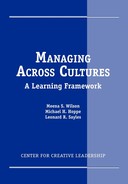Response to Ambiguity: Dynamic-Stable
How acceptable is uncertainty? Is loose or tight structure preferred for running the business organization?
In societies near the Dynamic pole, people accept ambiguity as a natural part of life. They do not shy away from conflict, dissent, or competition. In fact, they view these as potentially beneficial. They value flexibility, adaptability, and change and are open to adjusting existing rules or regulations as the situation demands. They are willing to take risks even in unfamiliar circumstances.
A can-do mentality is pervasive in the U.S. The words new and improved exemplify the value placed on development and innovation. Traditional practices are often ignored or satirized, and the status quo is usually questioned. These attitudes provide the drive, excitement, and energy that can be a source of organizational effectiveness.
However, many U.S. managers may not be as good at dealing with ambiguity as we would like to think. Situations in which the outcomes are highly unpredictable can create intolerable anxiety. Each culture teaches people a preferred strategy for responding to unstructured and confusing situations. Thus, in the U.S., continual data-gathering combined with procedures for constantly cross-examining decisions helps managers cope with uncertainty.
In societies near the Stable pole, people are more likely to shun unpredictable situations. They become nervous when encountering change, conflict, or competition in their work and try to avoid them through clearly defined rules, regulations, and policies. By eschewing unclear situations and unfamiliar risks, they hope to avoid the stress of mistakes and failure.
Continuity is valued and change is considered disruptive. For example, in Japan, when new management is brought in, there is an emphasis on preserving earlier rituals and traditions rather than supplanting them.
These values affect the following preferences.
Structure of work life. Presently in the U.S., companies are experimenting with flattened hierarchical structures, decentralization, matrix management, cross-functional teams, and other ways of restructuring organizations and the flow of work.
In cultures where stability is valued more than dynamism, employees may become confused when their work situation is too fluid and not well-defined. Detailed job descriptions are preferred. Subordinates want their managers to have precise answers to most of the questions they raise about their work. A structure in which a subordinate can have two bosses is seen as absurd. Workers strongly feel a need for rules and procedures.
Paradoxically, these rules and procedures then may be ignored by individuals, as for example when a manager seeks “forgiveness rather than permission” for a special project initiative.
“One best way” answers to problems. Believing in their own ability to respond dynamically to novel situations, U.S. managers tend to presume that a “new” right answer can be found to address most management issues. As indicated by the popularity of research on best practices, U.S. management often believes that there is one best way of structuring an organization, supervising employees, designing a compensation system, and so on. The assumption is that empirical inquiry or trial and error can be used to devise solutions to most problems. Changing management fads are also an example of this: Each fad is perceived for a time as a solution to all that ails management.
In dealing with the complexity of running large domestic or multinational companies, strong staff groups often impose these generic standards or operating rules on diverse parts of their organizations. As is evident in the global arena, one-best-way applications are often incompatible with local needs. For this reason, the efforts of U.S. companies to export the U.S. version of procedures or of products and advertising can sometimes fail.
Different people and ideas. The U.S. Constitution guarantees its citizens the right to hold dissenting views. A diversity of beliefs is tolerated. All people are relatively free to express viewpoints that may seem deviant to others and to challenge the authority of existing institutions. Petitions, demonstrations, and boycotts are acceptable because there is a commitment to upholding the values that create a pluralistic society.
These principles have found their way into the workplace as well; managers strive, not always successfully, to implement affirmative-action policies and other practices that support diversity.
In several parts of the world this tolerance in the U.S. of people with different ideas is viewed with suspicion and regarded as morally backward. Both socially and politically, the practice in these parts of the world is to repress and even persecute subpopulations whose origins can be traced to another ethnic, racial, or religious background—their views seem inferior to those held by the ruling majority. This makes intergroup strife more likely, and such tensions find their way into the workplace as well.
Thus, for example, in order to run an efficient manufacturing operation abroad, a U.S. manager may find that the company’s human resources department has to adopt a policy of hiring people who come from the same ethnic or linguistic or tribal background. Otherwise, interactions that provoke work disruption and even violence are likely.
